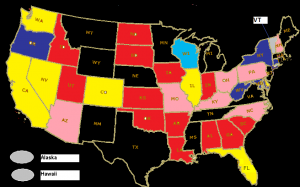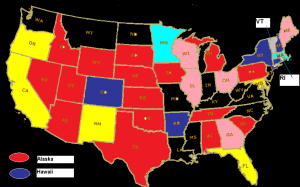2010 Election Predictions – How we rank individual races
Our calls on individual races are based on a composite of polls conducted over the last 28 days (we will compress this “look back period” to 14 days after Labor Day, since that’s when voters will start to pay attention to these races) using the following criteria:
(1) Safe Democratic (dark blue on the map)/Safe Republican (dark red on the map) – either a candidate leads by 10 or more points, or a candidate has over 50% in polls;
(2) Lean Democratic (light blue on the map)/Lean Republican (light red on the map) – a candidate leads by 3-9 points;
(3) Tossup (yellow) – a candidate leads by less than 3 points;
(4) No data available/primary has not been held (gray) – In general, we don’t analyze statewide polls until its primary has been conducted. However, since pollsters have been releasing multiple polls with different Democratic vs Republican matchups for states that have not held their primaries, we will modify this rule as follows: if at least one of the major parties has a clear front runner in a contested primary, we will use the various poll matchups to get a sense of how a Senate/Governor race is leaning and, based on that composite of polls in the last 28 days, will assess which party is ahead.
(5) No Senate/gubernatorial race in 2010 for this state (black);
For the past two weeks, the following has changed with regards to poll numbers released: (1) Democratic polling firm Public Policy Polling (PPP) is now using a “likely voter” model for determining its poll sample – this theoretically will produce more Republican poll samples (its effect was clearly seen on a recent poll on the Louisiana Senate race ), and (2) Rasmussen is now using follow up question(s) to get initially undecided voters to indicate a preference for one of the candidates (this action will cause the undecided number to plummet). We will report both numbers Rasmussen uses for purposes of our poll analysis.
2010 Election Predictions – Senate Races
(8/19 and 8/26 projections: 55 Democrats, 45 Republicans, or Republican gain of +4)
(8/11 projection: 54 Democrats, 46 Republicans, or Republican gain of +5)
Since our last analysis, we have moved the California Senate race from “leans Republican” to “Tossup” due to recent polls showing the race significantly tightening. While the past 28 days of polling shows a Boxer lead of 44-42, polling taken in the past two weeks shows a 45-45 tie.
Six things on the map are worth noting: (1) We do not yet have poll data for the Alaska, Hawaii, and Vermont Senate races. Vermont and Alaska have just conducted their primaries, while Hawaii will not have its primary until September 18; (2) The Alaska race is complicated by the fact that its incumbent Republican senator currently trails her Republican challenger by 1,700 votes. 8400 absentee votes remain to be counted by September 8; (3) Though Wisconsin is “leans Democratic”, we need to reiterate that this is a 28 day average of how Russ Feingold would poll against multiple Republican candidates. Against GOP front-runner Ron Johnson, Feingold has trailed in the last three Rasmussen polls. Once Wisconsin holds its primary on September 14, we can probably reclassify this race; (4) a Democratic held seat in Colorado is a “tossup” because it includes polling conducted before the August 10 primary – if you look at the past 14 days, the Republican challenger leads appointed Senator Michael Bennet 48-41; (5) Florida has just conducted its primary. This means that Democratic voters will start to slide away from Independent Charlie Crist – in fact, the Republican has started to pull ahead in very recent polling; (6) In Washington state, now that all but a few thousand ballots out of 1.5 million votes cast have been counted, three term incumbent Democrat Patty Murray has only received 46% of the vote, with a combined Republican vote of 50%. In effect, we believe this is an early indicator of the November results for that state.
2010 Election Predictions – Governor’s Races
(8/26 projection: 31 Republicans, 19 Democrats, or Republican gain of +7)
(8/11 and 8/19 projections: 32 Republicans, 18 Democrats, or Republican gain of +8)
Since our last analysis, there have been three changes. Wyoming conducted its primaries on August 17, and initial polling shows the Republican challenger with a commanding 58-24% lead for this Democratic held seat. Recent polling conducted in Hawaii, however, shows either Democratic candidate well ahead of the likely GOP nominee (the primary is September 18) for this open Republican seat. Similarly, an open Republican seat in Rhode Island shows the Democrat moving ahead in the polls in what was once a “tossup” three way race.
A couple of things on the map are also worth noting: (1) while we have no poll data for Vermont, they just held their primary, so we expect to see poll data very soon; (2) In four states, Democratic leads in the polls are due to third party candidacies. In Colorado, the Republican and Constitution Party candidates are getting a combined 54% (as opposed to the Democrat ‘s 46%, and in a two way race, recent polling shows a tie). In Minnesota, the Republican/Independent total is 44%, compared to the 42% the Democrat is receiving. In Massachusetts, the embattled Democratic incumbent leads in the polls with an anemic 30%, while the Republican + Independent total is 41%. Finally, in Rhode Island, the Democrat “leads” with 39%, while the Republican + Independent total is 52%; (3) since we are currently using a 28 day lookback for polls, what is not being shown is that in California, a “tossup” 44-42 Republican lead is actually 48-42 if you look at the past 14 days.
2010 Election Predictions – Generic Congressional Vote
(8/26 poll composite: 46.7% Republican, 41.0% Democrat – +5.7% Republican)
(8/19 poll composite: 46.6% Republican, 41.2% Democrat – +5.4% Republican)
(8/11 poll composite: 45.3% Republican, 41.3% Democrat – +4.0% Republican)
Recent statements by both President Obama and House Speaker Nancy Pelosi (D-California) suggesting support for building a mosque near “Ground Zero” have not helped Democratic candidates. Nor has continued economic bad news. The overall negative climate for Democrats has now been detected by Democratic insiders: a pollster working several House races noted yesterday that “…“The reality is that [the House majority] is probably gone…”
To put the “Generic Congressional Vote” question in perspective, when Republicans retook the House (and Senate) in 1994, the popular vote in the 435 House districts was 52-45% Republican. If we were to split the undecideds equally between both parties, you would have a 53% Republican vote, which equates to a 230 seat Republican majority – a net gain of 51 Republicans, or 12 more than needed to regain control of the House. We also believe at this time that the 230 seat figure is a conservative estimate, since it doesn’t consider voter intensity, which clearly favors the Republicans right now. There’s another factor at play too: voters are not happy with Congressional incumbents, and in a recent Rasmussen poll, only 37% wanted to re-elect their own Congressman. Since 60% of incumbent House members are Democrats, this is obviously not a sentiment the Democrats want voters to have.
2010 Election Predictions – Individual House Races
(8/26: 253 Republicans/182 Democrats (+ 74 Republican, “Watch list” of 25 Democrats/2 Republicans)
(8/19: 254 Republicans/181 Democrats (+ 75 Republican, “Watch list” of 24 Democrats/1 Republican)
(8/11: 257 Republicans/178 Democrats (+ 78 Republican, “Watch list” of 19 Democrats)
One of the things we have repeatedly noted in our discussions of the “Obama plunge” and its effect on the fall elections is that actual poll results (and in the case of Washington state, open primary election results) take precedence over the theoretical criteria used to determine whether a seat is vulnerable. This past week, we have seen polls released for 14 House races. Though the numbers above would seem to signify a continued Democratic renaissance, the truth is actually the opposite. What we saw was the following:
(1) In 12 of the 14 House races, polling data confirmed our belief as to who was safe, on the “watch list”, or vulnerable;
(2) A formerly safe Democrat (22 year incumbent Frank Pallone of New Jersey) is now on the “watch list” on the basis of a recent poll showing him with a 40-34% poll lead. His district gave Obama 60% of the vote, and Rep. Pallone was re-elected with 67% of the vote in 2008. Since then, he has supported 100% of the Democratic leadership’s agenda;
(3) Freshman Democrat Kurt Schrader was thought to be vulnerable; we have placed him on the “watch list” for now, since conflicting polls released by both campaigns either show the incumbent with a 46-35% lead or show him trailing 38-41%. Without an independent poll, we can’t classify this race right now, although it’s worth noticing that both Shrader and Obama received 54% of the vote in this district, thus making the incumbent a candidate for the “Obama plunge.”
(4) There are two Republican open seats in Democratic leaning areas that are on the “watch list”, since the incumbents in both seats (Mike Castle in Delaware and Mark Kirk in Illinois) decided to run for the Senate, and in those open seat races, recent polling shows the Democratic candidates in the lead, but with less than 50% of the vote;
A final note on the polls so far: we have cumulatively seen polls done on 32 Democratic held seats where the Democrat is behind in the polls. On average, these districts voted 51% for Obama, which means that these seats are “Ground Zero” for the “Obama plunge.” Similarly, we have seen poll results for an additional 19 Democratic held seats where Democrats lead but with less than 50% – Obama on average got 52% in these districts, and these seats are similarly vulnerable against the “Obama plunge.” These 51 (last week, it wa 47) House seats alone can flip the House to Republican control. And keep in mind that there are 48 more vulnerable/”watch list” Democratic held seats where no polling has been done.
John is a political consultant and blogger with JMC Enterprises with expertise in poll sample development and analysis, development of targeted voter files for phone canvassing or mail outs, campaign strategy and demographic consulting, among other things. See his site at WinWithJMC.com for more information.
Advertisement
Advertisement


